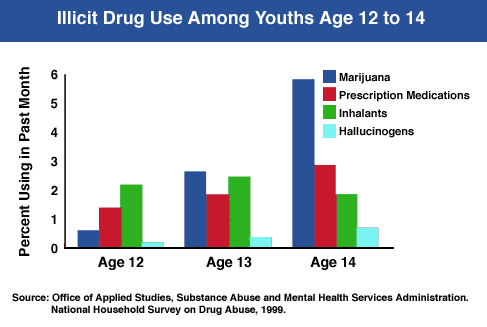
Prescription drugs can transform lives. For the millions of patients who take them, prescription drugs bring dramatic improvements in health and quality of life. But when abused or misused, many of these medications can have effects that disrupt rather than improve lives. Some prescription medications-particularly opioids, central nervous system (CNS) depressants, and stimulants-alter the brain's activity, and misuse or abuse of these drugs can lead to compulsive drug seeking and use, the hallmark of addiction.
Data from the National Household Survey on Drug Abuse reveal that an estimated 9 million Americans 12 years or older used prescription pain relievers, sedatives, or stimulants for nonmedical reasons in 1999; more than one-fourth of them reported that they had used prescription drugs nonmedically for the first time in the previous year.
The most dramatic increases in new nonmedical use of prescription drugs that act on the brain were among 12- to 17- and 18- to 25-year-olds. Elderly Americans-those 60 years and older-are three times more likely than the rest of the population to use prescription drugs. Research suggests that the elderly are less likely than younger patients to carefully follow instructions for taking medication, making them more vulnerable to the dangers of misuse of prescription drugs.
To help reverse these trends, NIDA is initiating several new projects. Some of these efforts are directed toward improving our understanding of the basic mechanisms involved in the action and effects of prescription drugs, as well as interactions that may occur between different medications when they are taken together. Other efforts seek to inform the general public and health care professionals of the risks of misuse of prescription drugs; a recent national survey revealed that 46.6 percent of primary care physicians find it difficult to discuss prescription drug abuse with patients for whom they prescribe the medications. For some patients, misunderstanding the risks of prescription drugs or failing to closely follow a medication regimen is what leads to misuse and addiction.

Data from the National Household Survey on Drug Abuse show that 12- to 14-year-olds reported prescription medications as one of two primary drugs used.
In April, NIDA launched a comprehensive public information campaign in response to the increased abuse of pain relievers and a growing concern over abuse of other prescription medications. Our partners in this effort are the American Pharmaceutical Association, the Pharmaceutical Research and Manufacturers of America, the American Academy of Family Physicians, AARP, the National Council on Patient Information and Education, the National Community Pharmacists Association, and the National Chain Drug Store Association.
NIDA has published a new Research Report, "Prescription Drugs: Abuse and Addiction," to answer questions about the consequences of abusing commonly prescribed medications. In addition to summarizing what research has taught us about how certain medications affect the brain and , the report also offers information to help patients, health care providers, and pharmacists prevent and identify misuse or abuse of prescription drugs. (See "Facts About Prescription Drug Abuse and Addiction").
As part of the public launch of NIDA's prescription drugs initiative, a panel of investigators briefed the press on important aspects of prescription drug misuse and abuse. (See "NIDA Scientific Panel Reports on Prescription Drug Misuse and Abuse"). One theme united all their presentations: We need to learn more.
In order to broaden and deepen our understanding of the extent of the problem of prescription drug abuse-to identify the drugs and classes of drugs that are being abused; to understand the pathways that lead from use to misuse, abuse, and addiction; and to identify populations most affected-NIDA has announced an expanded program of research into basic science, epidemiology, prevention, and clinical practices relevant to abuse and misuse of prescription drugs. (See Program Announcement PA-01-048)
This program will support investigations on all classes of prescription drugs with abuse liability, including analgesics, stimulants, sedative/hypnotics/anxiolytics, and muscle-building/performance-enhancing drugs such as anabolic steroids. The program will allow us to better understand the relationship between prescription medications, the conditions for which the medications are prescribed, and environmental and individual factors that might contribute to abuse. It will facilitate research into questions such as:
- whether some prescription medications can trigger relapse in former drug abusers;
- whether some patient populations receive too little medication to meet their needs or so much medication that they are needlessly at risk for adverse effects;
- what types of prevention programs can effectively lower risk for prescription drug misuse and abuse, particularly among patient populations with high vulnerability;
- how to improve the recognition and assessment of prescription drug misuse and abuse among patients being treated for disorders such as acute and chronic pain or psychiatric illnesses;
- how to treat pain, anxiety, sleep disorders, and other conditions in patients with histories of abusing the medications that are commonly used to treat those conditions; and
- how to help patients maintain abstinence from prescription drug abuse.
Taken together, our initiatives will significantly reduce the public health and social consequences associated with prescription drug abuse or misuse and help assure that prescription medications, which play such a vital role in the lives of millions of patients, continue to heal and help.
